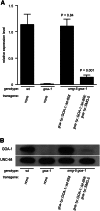A novel strategy for cell-autonomous gene knockdown in Caenorhabditis elegans defines a cell-specific function for the G-protein subunit GOA-1
- PMID: 23525334
- PMCID: PMC3664847
- DOI: 10.1534/genetics.113.149724
A novel strategy for cell-autonomous gene knockdown in Caenorhabditis elegans defines a cell-specific function for the G-protein subunit GOA-1
Abstract
We developed a novel knockdown strategy to examine cell-specific gene function in Caenorhabditis elegans. In this strategy a null mutation in any gene is replaced with a genetically stable transgene that contains a wild-type copy of the gene fused to a 3' tag that targets the mRNA transcript for degradation by the host nonsense-mediated decay (NMD) machinery. In NMD-defective animals, tagged transgene mRNA is expressed at levels similar to the endogenous gene it replaced and is translated into wild-type protein that fully rescues gene function. Cell-specific activation of NMD cell autonomously knocks down transgene expression in specific cell types without affecting its expression or function in other cells of the organism. To demonstrate the utility of this system, we replaced the goa-1 gene, encoding the pan-neuronally expressed G-protein subunit GOA-1, with a degradation-tagged transgene. We then knocked down expression of the transgene from only two neurons, the hermaphrodite-specific neurons (HSNs), and showed that GOA-1 acts cell autonomously in the HSNs to inhibit egg-laying behavior.
Keywords: RNA interference; gene expression; gene knockdown; nonsense-mediated decay.
Figures




Similar articles
-
SMG-ly knocking out gene expression in specific cells: an educational primer for use with "a novel strategy for cell-autonomous gene knockdown in caenorhabditis elegans defines a cell-specific function for the G-protein subunit GOA-1".Genetics. 2013 Dec;195(4):1201-7. doi: 10.1534/genetics.113.157701. Genetics. 2013. PMID: 24302743 Free PMC article.
-
STR-33, a novel G protein-coupled receptor that regulates locomotion and egg laying in Caenorhabditis elegans.J Biol Chem. 2011 Nov 18;286(46):39860-70. doi: 10.1074/jbc.M111.241000. Epub 2011 Sep 21. J Biol Chem. 2011. PMID: 21937442 Free PMC article.
-
Activation of EGL-47, a Galpha(o)-coupled receptor, inhibits function of hermaphrodite-specific motor neurons to regulate Caenorhabditis elegans egg-laying behavior.J Neurosci. 2004 Sep 29;24(39):8522-30. doi: 10.1523/JNEUROSCI.1915-04.2004. J Neurosci. 2004. PMID: 15456826 Free PMC article.
-
Heterotrimeric G proteins in C. elegans.WormBook. 2006 Oct 13:1-25. doi: 10.1895/wormbook.1.75.1. WormBook. 2006. PMID: 18050432 Free PMC article. Review.
-
mRNA Editing, Processing and Quality Control in Caenorhabditis elegans.Genetics. 2020 Jul;215(3):531-568. doi: 10.1534/genetics.119.301807. Genetics. 2020. PMID: 32632025 Free PMC article. Review.
Cited by
-
Genetic modeling of GNAO1 disorder delineates mechanisms of Gαo dysfunction.Hum Mol Genet. 2022 Feb 21;31(4):510-522. doi: 10.1093/hmg/ddab235. Hum Mol Genet. 2022. PMID: 34508586 Free PMC article.
-
Decoding GNAO1 mutations using Caenorhabditis elegans model system: past approaches and future prospectives.Front Cell Neurosci. 2025 Jul 23;19:1633744. doi: 10.3389/fncel.2025.1633744. eCollection 2025. Front Cell Neurosci. 2025. PMID: 40771566 Free PMC article. Review.
-
G Proteins and GPCRs in C. elegans Development: A Story of Mutual Infidelity.J Dev Biol. 2018 Nov 25;6(4):28. doi: 10.3390/jdb6040028. J Dev Biol. 2018. PMID: 30477278 Free PMC article. Review.
-
SMG-ly knocking out gene expression in specific cells: an educational primer for use with "a novel strategy for cell-autonomous gene knockdown in caenorhabditis elegans defines a cell-specific function for the G-protein subunit GOA-1".Genetics. 2013 Dec;195(4):1201-7. doi: 10.1534/genetics.113.157701. Genetics. 2013. PMID: 24302743 Free PMC article.
References
-
- Alfonso A., Grundahl K., Duerr J. S., Han H. P., Rand J. B., 1993. The Caenorhabditis elegans unc-17 gene: a putative vesicular acetylcholine transporter. Science 261: 617–619. - PubMed
Publication types
MeSH terms
Substances
Grants and funding
LinkOut - more resources
Full Text Sources
Other Literature Sources
Molecular Biology Databases

